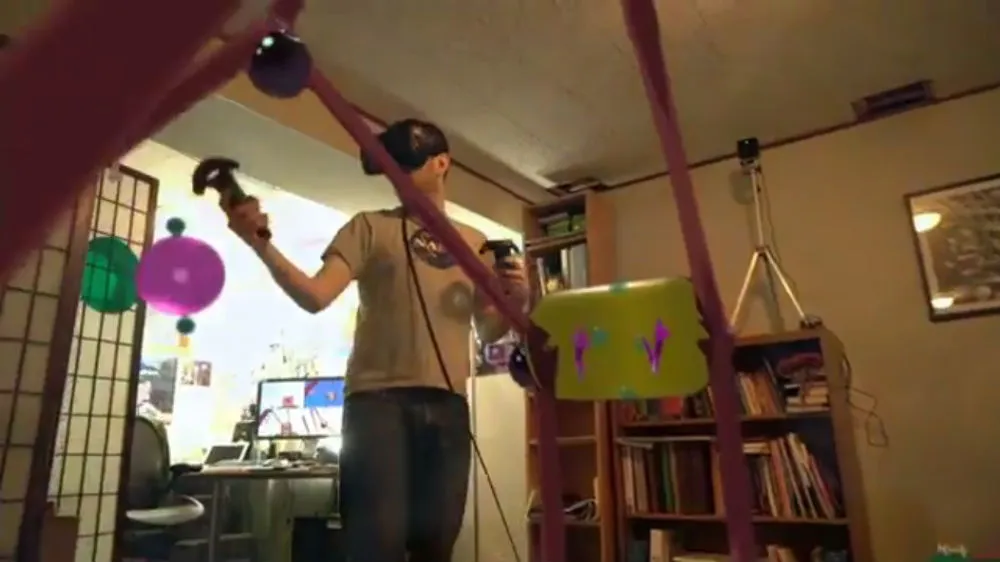The mixed reality capture of VR experiences Kert Gartner is pioneering with VR developers could represent a revolution in the way digital games are watched and marketed.
The above video is only 23 seconds long and what you see happens so quickly it might not be easy to process the significance, so I’ll break it down.
We’ve been following the mixed reality streaming technology being pioneered by Northway Games, the husband-and-wife team Colin and Sarah Northway, who are working with Radial Games to build creativity-puzzle game Fantastic Contraption for the HTC Vive. The game is a launch title that will be bundled with pre-orders for the $800 holodeck-like system, alongside Job Simulator by Owlchemy Labs.
Their videos are made using a green screen, webcam and a powerful PC to mix and match real-world footage with footage from a virtual world. They show a single stationary view of mixed reality, allowing people at home to see what a person sees in VR as they interact naturally with a virtual world.
The videos do an extraordinary job of conveying — live to viewers over Twitch — what a person in VR is experiencing. The intense emotions unlocked by VR and natural hand, arm, body and head movements can be seamlessly combined with the virtual environment a person is visiting and shown to spectators all over the world. The promise of what the Northways are working on is that the interplay between a human and a virtual world might soon be presentable to millions of people both cheaply and easily. You won’t need VR hardware to understand exactly what a variety of VR games will feel like to play. You can just watch a video.
This is an early sample video produced by Northway Games:
Gartner is taking what the Northways are doing and pushing it a step further, attaching a Vive controller to a camera to track its movement and using a stabilization rig to get a nice cinematic-looking shot. His experiments with the technology are evolving rapidly.
The future is held together with gaffer tape and elastic bands (for now) 😀 better setup coming on Monday!! pic.twitter.com/211aJIV4hW
— Kert Gartner (@kertgartner) February 19, 2016
This rig should be a bit better 😀 #VR #thefuture pic.twitter.com/dOfjWhuE9x
— Kert Gartner (@kertgartner) February 22, 2016
When combined in post-production with the virtual environment a person sees, it looks like the future of game trailers and eSports.
“What we’re doing is not complicated — there’s nothing proprietary with what we’re doing here,” Gartner told UploadVR in a phone interview. “There’s not many technical leaps you need to make to put this together in your basement.”
Gartner has been working full-time for the last couple years creating game trailers for indie game developers. With the blossoming VR market and the possibility the Northways could release their mixed reality streaming technology as a Unity plug-in, it could have a multiplying effect on the budding market. Marketers and game developers are still trying to understand how to show what a game in VR feels like to play. It’s a struggle to convey how natural VR feels to even die-hard videogamers — likely the first buyers of VR equipment — let alone a person reluctant to learn a new technology platform. That all can change if people at home can watch YouTube videos of teenagers and grandparents alike interacting with virtual worlds as naturally as the real one.
We’ll keep following future developments closely. The next step for Gartner is to test his work out on a green screen.
Things will be happening here sooooon! 😀 #VR #thefuture pic.twitter.com/FaDLuopkjO
— Kert Gartner (@kertgartner) February 22, 2016

























